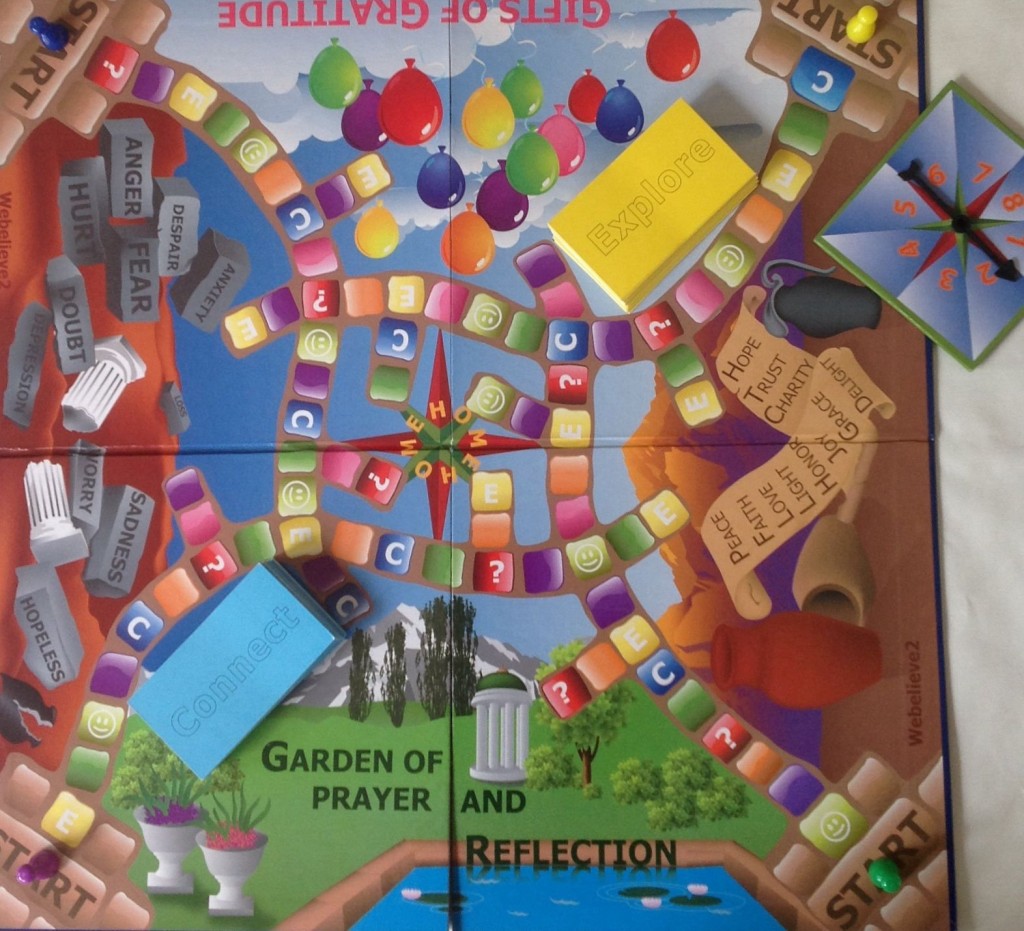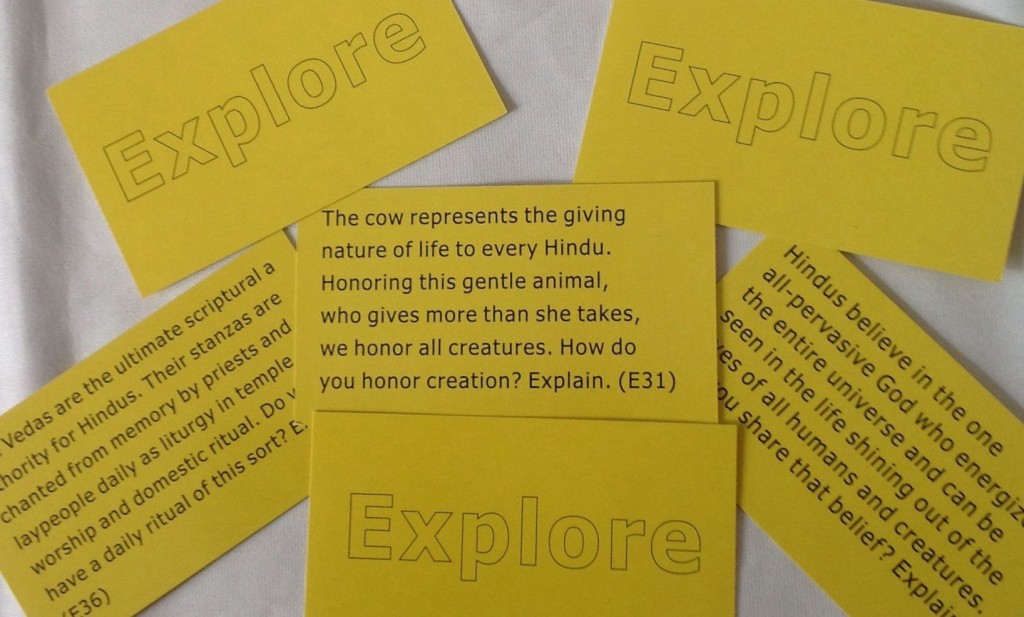 Interreligious dialogue and notions of tolerance, while suggesting inclusivity, often employ exclusions that identify insiders and outsiders, although these insiders and outsiders are different than the boundaries commonly employed in communities. An interesting example of this paradox is Webelieve2, a board game advertised as encouraging discussion among people with different religious commitments. The game is designed to create an opportunity to “learn about others” and “to connect with others.” While targeted marketing to Religious Studies professorsassumes certain interests inform the study of religion (several of my colleagues and I recently received emails advertising this game), the game also reflects particular assumptions about religion that create a variety of exclusions that seem to counter the instructions’ interest in creating an environment where “people feel ‘safe’ when sharing.”
Interreligious dialogue and notions of tolerance, while suggesting inclusivity, often employ exclusions that identify insiders and outsiders, although these insiders and outsiders are different than the boundaries commonly employed in communities. An interesting example of this paradox is Webelieve2, a board game advertised as encouraging discussion among people with different religious commitments. The game is designed to create an opportunity to “learn about others” and “to connect with others.” While targeted marketing to Religious Studies professorsassumes certain interests inform the study of religion (several of my colleagues and I recently received emails advertising this game), the game also reflects particular assumptions about religion that create a variety of exclusions that seem to counter the instructions’ interest in creating an environment where “people feel ‘safe’ when sharing.”
The game reflects particular assumptions about religion that emphasizes belief over action. The direct questions within the game almost exclusively focus on interpretation and philosophical reflection, specifying particular beliefs and concepts that the game attributes to followers of a particular religion. The game asks players to discuss what they think about these ideas personally or within their community. In this sense, the game reinforces the dominant view in society, commonly associated with Protestantism, that proper, individual belief is the central concern and practices are of secondary importance. Such a view has also greatly influenced the formation of the field of religious studies, with the emphasis on text and belief, that has been critiqued significantly in the past several decades (but remains pretty consistent, nonetheless).
By drawing quotes from particular religions, the game also makes selections about which are significant enough to be included. The creators attribute most of the quotes and ideas to followers of Christianity, Islam, Hinduism, and Buddhism, while Confucianism, Bahai, Judaism, Voodoo, Sikhism, Jainism, and recovery programs are among some of the labels that receive a few references. Shinto, Daoism, Paganism, Native American, and other communities do not rate highly enough in the constructions of the creators to receive a direct reference.
 In presenting these quotes from specific traditions, the language often valorizes particular interpretations, despite the concept of safe inclusion. For example, the center card pictured above declares that “every Hindu” reveres cows, even though the reverence for cattle has not always been so prominent, arising particularly in the past two centuries, in part as a distinction from people identified as Muslim in India. For those who identify as Hindus and eat beef (yes, some do), this phrasing marginalizes them, implying that they are not good Hindus.
In presenting these quotes from specific traditions, the language often valorizes particular interpretations, despite the concept of safe inclusion. For example, the center card pictured above declares that “every Hindu” reveres cows, even though the reverence for cattle has not always been so prominent, arising particularly in the past two centuries, in part as a distinction from people identified as Muslim in India. For those who identify as Hindus and eat beef (yes, some do), this phrasing marginalizes them, implying that they are not good Hindus.
This promotion of particular positions extends further to particular values that participants obviously should endorse. That same card asks, “How do you value creation?” Focusing on valuing this physical world might not be important to every potential participant. In fact, some might contest concern about this environment in favor of a more thorough focus on things beyond this physical world. Certainly, the card could generate that discussion, but the implicit message is that people should be concerned about the environment. While I largely agree with that message, imposing it implicitly forces people who disagree to the margins of the group.
The entire concept, in fact, assumes that participants hold a particular view that acknowledges a certain level of commonality between religions. In the game, players are sent to common locations (the desert to discuss how their “faith” sustains them through difficult experiences or the “Garden of Prayer and Reflection” to share a concern and request prayer/words of encouragement). These practices presume an openness to common participation in activities like prayer. More significantly, all paths in the game lead players to reach a common home. Does this imply that all religions are different paths to the same goal? Even if you do not accept that analysis of the game design, the notion of commonality throughout the game assumes particular theological.philosophical positions. While such ideas have an attractiveness, like that warm and fuzzy feeling of everyone singing Kumbaya together, such assertions directly contradict the concepts that some people in a wide variety of religions maintain. People who assume that their religion is uniquely correct or that other religions are dangerous/false, are effectively excluded.
Interreligious dialogue and games like Webelieve2 can certainly be meaningful for participants, but they also serve as strategies of identification, bringing together people who may hold different religious identifications to promote particular values of tolerance and inclusion in common. Creating a notion of positive identification among participants is built upon a requirement of acceptance of particular positions, thus excluding and disciplining those who question those values. Not really a surprise, as processes of identification operate this way, unless you accept their own rhetoric of inclusion.

As creator of the game, “webelieve2,” I found your assumptions about the game interesting. However, it appears that you may not have actually played the game. For those who have, it becomes a tool for conversations that may not otherwise occur.
My intent in creating the game, was primarily to promote conversation between folks of different faith communities as to how their beliefs impact their personal life and their interactions with others.
Thanks for visiting Culture on the Edge and taking the time to comment. I certainly expect that the game generates some interesting conversations. My analysis, though, focuses on the ways that many interreligious efforts like this game can valorize particular assumptions about religion in general and practices and beliefs associated with a specific religion. It also adopts and reinforces particular constructions of those religions that can marginalize some. As an example, the common trope that “every Hindu” has a set attitude towards the cow imposes that understanding on people who identify as Hindu but do not hold the same reverence. Moreover, the cow protection movement that stems from this type of assertion has been used by some in India to marginalize and restrict the practices of minorities (some of whom consume beef). Such generalizations, then, are not only inaccurate but also supportive of politically contested ideas.